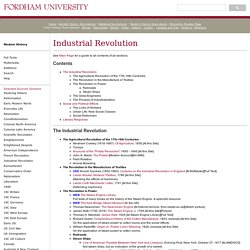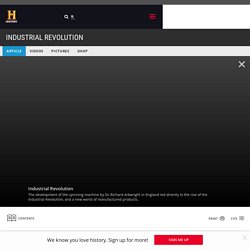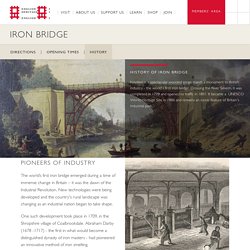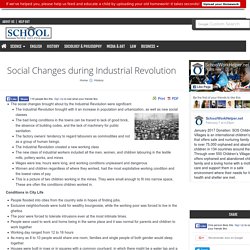

Industrial Revolution in Britain: Resources. Internet History Sourcebooks. Industrial Revolution See Main Page for a guide to all contents of all sections.

Contents The Industrial Revolution The Agricultural Revolution of the 17th-18th Centuries The Revolution in the Manufacture of Textiles The Revolution in Power Railroads Steam Ships The Great Engineers The Process of Industrialization Social and Political Effects The Lives of Workers Urban Life: New Social Classes Social Reformism Literary Response The Industrial Revolution The Agricultural Revolution of the 17th-18th Centuries Abraham Cowley (1618-1667): Of Agriculture, 1650 [At this Site] Turnips Accounts of the "Potato Revolution" 1695 - 1845 [At this Site] John A.
Mazis: The Potato [Modern Account][At UMN] Field Rotation Animal Breeding The Revolution in the Manufacture of Textiles 2ND Arnold Toynbee (1852-1883): Lectures on the Industrial Revolution in England [At McMaster][Full Text] Leeds Woolen Workers' Petition, 1786 [At this Site] Attacking the effects of machinery. Inventors and Inventions of the Industrial Revolution. History - British History in depth: Agricultural Revolution in England 1500 - 1850. KS3 Bitesize History - The Industrial Revolution : Revision, Page 9. Industrial Revolution Timeline. Industrial Revolution - Facts & Summary.
The textile industry, in particular, was transformed by industrialization.

Before mechanization and factories, textiles were made mainly in people’s homes (giving rise to the term cottage industry), with merchants often providing the raw materials and basic equipment, and then picking up the finished product. Workers set their own schedules under this system, which proved difficult for merchants to regulate and resulted in numerous inefficiencies. In the 1700s, a series of innovations led to ever-increasing productivity, while requiring less human energy. For example, around 1764, Englishman James Hargreaves (1722-1778) invented the spinning jenny (“jenny” was an early abbreviation of the word “engine”), a machine that enabled an individual to produce multiple spools of threads simultaneously.
By the time of Hargreaves’ death, there were over 20,000 spinning jennys in use across Britain. Developments in the iron industry also played a central role in the Industrial Revolution. History of Iron Bridge. A curious construction "It is one arch, a hundred feet broad, fifty-two high, and eighteen wide; all of cast-iron, weighing many hundred tons.

I doubt whether the Colossus at Rhodes weighed much more. " - John Wesley, 1779 (Anglican cleric and theologian). Although Darby commissioned many paintings and engravings of the finished bridge, a lack of images or eye witness accounts meant that for over 200 years, little was known of exactly how Darby managed to erect this almost 400 ton structure. But in 1997, a small watercolour sketch by Elias Martin, which illustrated the building of the bridge was discovered in a Stockholm museum. This exciting find, along with recent research, revealed much about the building process. While Darby's accounts do suggest the use of scaffold poles, timber and rope during construction, Martin's painting shows a wooden framework used to raise the half-ribs from the deck of a vessel.
Power Machinery - Google Arts & Culture. Social Changes during Industrial Revolution. The social changes brought about by the Industrial Revolution were significant The Industrial Revolution brought with it an increase in population and urbanization, as well as new social classes The bad living conditions in the towns can be traced to lack of good brick, the absence of building codes, and the lack of machinery for public sanitation.

The factory owners’ tendency to regard labourers as commodities and not as a group of human beings.The Industrial Revolution created a new working classThe new class of industrial workers included all the men, women, and children labouring in the textile mills, pottery works, and minesWages were low, hours were long, and working conditions unpleasant and dangerousWomen and children regardless of where they worked, had the most exploitative working condition and the lowest rates of pay.This is a picture of two children working in the mines. They were small enough to fit into narrow space.
These are often the conditions children worked in. St. Web Links - The Industrial Revolution. Victorian Britain.